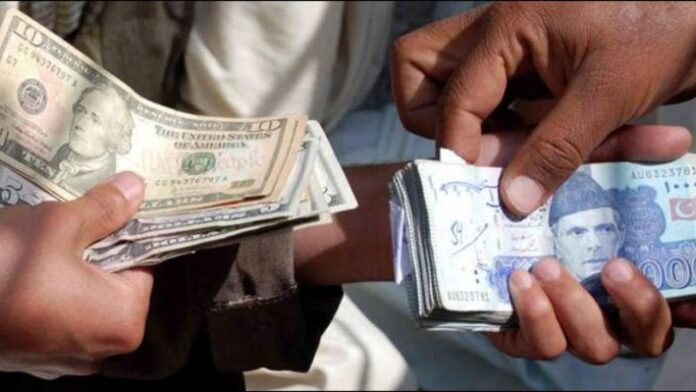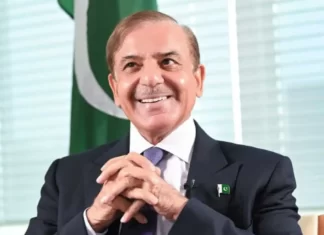LAHORE: Despite a tense start to the morning in Pakistan’s foreign currency market, the dollar rate in Pakistan defied expectations and managed not to jump particularly high after the country’s exchange companies announced they would be removing the artificial cap on the rupee-dollar parity.
A day earlier, the Exchange Companies Association of Pakistan (ECAP) announced in a dramatic statement that money changers would remove the cap on the dollar. This had driven speculation that the greenback could go berzerk on the open market despite the desperate efforts of the federal government to the contrary.
With all eyes on exchange companies, the dollar opened at Rs 251 at the start of the day but closed at Rs 242 by the close of market. The threat from ECAP lasted all of one hour before the exchange companies and the central bank sorted out their differences and reached a consensus.
Tensions quickly dissolved into negotiations with the ECAP and the State Bank of Pakistan (SBP), and the rate of the dollar on the open market ended up being decided behind closed doors rather than by market forces. So what exactly went down yesterday, and how did we get here?
The build-up
It all started on Monday, when the central bank suspended 11 outlets of 8 Exchange Companies for 7-15 days for hoarding dollars. The SBP used a technique called “mystery shopping” to catch these violators. Through this technique, a team from the SBP posed as regular customers and found that these outlets were refusing to sell dollars despite having them available at their counters. These outlets would buy dollars at the artificially low buying rate set by the SBP, but would then refuse to sell them at the low sell rate set by the SBP, despite the allowed spread between the two rates.
This led to what ECAP calls ‘confusion’ between the SBP and the exchange companies, with the SBP feeling that the exchange companies were hoarding dollars and blackmailing the government. In response, the ECAP called a nationwide meeting on Tuesday and announced that they would remove the artificial cap on the dollar rate, claiming that this was in the larger interest of the country. But was this announcement really made out of the goodness of their hearts? Some analysts believe that the real reason for this announcement was the action taken by the SBP the day before and that it was a pressure tactic and retaliatory action by the ECAP.
How day one played out
Fast forward to the next day (Wednesday), when the market opened, currency exchanges were initially unwilling to trade, saying that they had not received the opening rates for the day from ECAP. However, at around 10:30 AM, the currency exchange companies announced a little more than a ten rupee increase in the dollar rate.
This was the highest increase in dollar rate in a single day, and as the news started coming in tensions continued to rise and along with them the anxieties of people buying and selling dollars. People were now free to buy and sell dollars at this market rate. Despite this official position, the reality on the ground was different. Individual exchange companies were still not selling dollars, citing unavailability. “First people need to sell at Rs250, for us to sell further at Rs 252.5”, said one currency dealer talking to Profit.
This no-cap system lasted all of an hour. Even as your correspondents were closely monitoring the market’s reaction to this new reality of no artificial controls, the cap was put back in place by 11 30 AM.
The Dollar rate ping-pong
All this time, apparently the real decisions were not taking place in the open market, but behind closed doors. There was a meeting going on at the SBP between representatives of the ECAP and the SBP. When that meeting ended, the ECAP instructed all their members to reduce the Rs 10 increase announced earlier and start transacting at an average rate of Rs 242. This meant that, as also witnessed in the past week or so, there would only be a minimal change of a little more than a single rupee and nothing more than that. And more importantly, as witnessed in the past few months, there would be no market forces at play.
A Forex player on condition of anonymity told Profit, “It is likely that the ECAP would have agreed to follow SBP’s instructions once again in return for verbal assurances from the SBP, that it will in future take a more lenient view if a particular outlet of an exchange company was found to be hoarding some dollars, and treat it is a one of case being committed by a single employee and not to consider it the policy of the company.”
Another currency dealer told Profit that “when we opened the market today at the increased rate of Rs 250, we noticed that not many people were willing to sell even at this increased rate. It seemed that the strategy of the ECAP had backfired, as the currency exchange companies will now have to purchase dollars at a higher price and sell them at the normal margin, instead of their previous practice of buying at a very low rate and selling in the black market. The only way for the currency exchange companies to have made the same level of profit would have been if there was a higher volume of trade. However, people were not willing to sell at this rate either. Additionally, by this move ECAP may have also upset the SBP and the government.”
ECAP’s version. Believe it if you can
In response to a question about the recent meeting between the ECAP and the Deputy Governor of the State Bank, Secretary General of ECAP, Zafar Paracha, stated that the exchange rate values of the open market were not even discussed in the meeting. According to him the decision to make the increase gradual, a few rupees every day, until it reaches the market value was made to avoid unnecessary panic in the market.
The dollar is currently selling around Rs. 265/USD in the black market, and the ECAP believes that their rate should be upwards of 255 to reclaim their share of the trade. “We look forward to going to that mark in a few weeks”, said Mr. Paracha.
Despite suspicions, Mr. Paracha stated that the State Bank of Pakistan is not meddling with the open market value of the dollar, and that the decision to make the increase gradual was completely the ECAP’s own decision, in the greater interest of the country.

























Yes dollar rate is rising day by day like petrol price.
So what exactly went down yesterday
Aquarius January 2023 horoscope, Aquarius January 2024 Predictions, Aquarius January 2023 Daily Weekly, Kumbha Rashi, Kumbh Rasi, Aquarius Daily
thank you for this way
There are mafias working in all fields,we do not care
about country but our benefit
thanks nice post